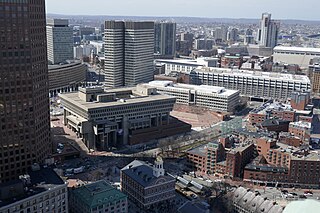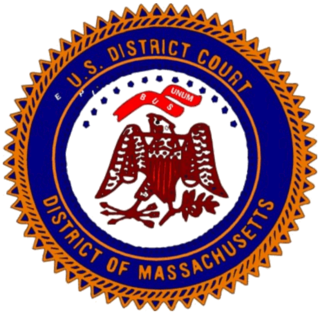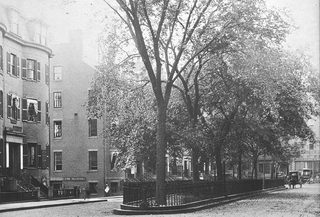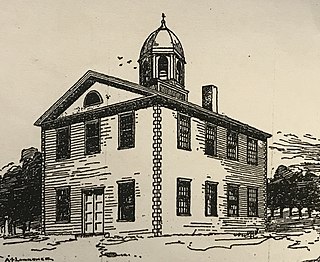
Middlesex County is a county located in the Commonwealth of Massachusetts, United States. As of the 2020 census, the population was 1,632,002, making it the most populous county in both Massachusetts and New England and the 22nd most populous county in the United States. This also makes the county the most populous county on the East Coast outside of New York or Florida. Middlesex County is one of two U.S. counties to be amongst the top 25 counties with the highest household income and the 25 most populated counties. It is included in the Census Bureau's Boston–Cambridge–Newton, MA–NH Metropolitan Statistical Area. As part of the 2020 United States census, the Commonwealth's mean center of population for that year was geo-centered in Middlesex County, in the town of Natick.

Edward William Brooke III was an American lawyer and politician who represented Massachusetts in the United States Senate from 1967 to 1979. A member of the Republican Party, he was the first African American elected to the United States Senate by popular vote. Prior to serving in the Senate, he served as the Attorney General of the Commonwealth of Massachusetts from 1963 until 1967. Edward Brooke was the first African-American since Reconstruction in 1874 to have been elected to the United States Senate and he was the first African-American United States senator since 1881 to have held a United States Senate seat. Edward Brooke was also the first African-American United States senator ever to have been re-elected to the United States Senate.

Government Center is an area in downtown Boston, centered on City Hall Plaza. Formerly the site of Scollay Square, it is now the location of Boston City Hall, courthouses, state and federal office buildings, and a major MBTA subway station, also called Government Center. Its development was controversial, as the project displaced thousands of residents and razed several hundred homes and businesses.

The United States District Court for the District of Massachusetts is the federal district court whose territorial jurisdiction is the Commonwealth of Massachusetts, United States. The first court session was held in Boston in 1789. The second term was held in Salem in 1790 and court session locations alternated between the two cities until 1813. That year, Boston became the court's permanent home. A western division was opened in Springfield in 1979 and a central division was opened in Worcester in 1987. The court's main building is the John Joseph Moakley Federal Courthouse on Fan Pier in South Boston.

Post Office Square in Boston, Massachusetts, is a square located in the financial district at the intersection of Milk, Congress, Pearl and Water Streets. It was named in 1874 after the United States Post Office and Sub-Treasury which fronted it, now replaced by the John W. McCormack Post Office and Courthouse.

Scollay Square was a city square in downtown Boston, Massachusetts. It was named for William Scollay, a prominent local developer and militia officer who bought a landmark four-story merchant building at the intersection of the Cambridge and Court Streets in the year 1795. Local citizens began to refer to this intersection as Scollay's Square, and, in 1838, the city officially memorialized the intersection as the Scollay Square. Early on, the area was a busy center of commerce, including daguerreotypist (photographer) Josiah Johnson Hawes (1808–1901) and Dr. William Thomas Green Morton, the first dentist to use ether as an anaesthetic.

Fort Point is a neighborhood or district of Boston, Massachusetts, and where a fort stood which guarded the city in colonial times.

The Massachusetts Appeals Court is the intermediate appellate court of Massachusetts. It was created in 1972 as a court of general appellate jurisdiction. The court is located at the John Adams Courthouse at Pemberton Square in Boston, the same building which houses the Supreme Judicial Court and the Social Law Library.

The Middlesex County Courthouse is a historic courthouse building in East Cambridge, Massachusetts. It was initially designed in 1814-1816 by noted architect Charles Bulfinch (1763–1844), and subsequently enlarged in 1848 by Ammi B. Young.

The Boston Government Service Center (BGSC) is a state government complex in the West End of Boston, Massachusetts. The center was designed in the Brutalist style, led by architect Paul Rudolph. It is one of the major components of the Government Center complex in Downtown Boston. The complex is made up of two connected Brutalist buildings: the Charles F. Hurley Building and the Erich Lindemann Building, as well as a courtyard; sometimes included is the newer, 1998-built, Edward W. Brooke Courthouse.

The Leader Bank Pavilion is an outdoor amphitheater located in Boston, Massachusetts, used for concerts. It seats 5,000. Its season runs from May until October. The venue originally opened in August 1994 near Fan Pier. Due to land rights, it closed at the end of its season in 1998 and the tensile structure was relocated to its current location in South Boston, where it reopened in July 1999.

The Provident Institution for Savings (est.1816) in Boston, Massachusetts, was the first chartered savings bank in the United States. James Savage and others founded the bank on the belief that "savings banks would enable the less fortunate classes of society to better themselves in a manner which would avoid the dangers of moral corruption traditionally associated with outright charitable institutions."

Pemberton Square in the Government Center area of Boston, Massachusetts, was developed by P.T. Jackson in the 1830s as an architecturally uniform mixed-use enclave surrounding a small park. In the mid-19th century both private residences and businesses dwelt there. The construction in 1885 of the massive John Adams Courthouse changed the scale and character of the square, as did the Center Plaza building in the 1960s.

The Boston Opera House, also known as the Citizens Bank Opera House, is a performing arts and esports venue located at 539 Washington St. in Boston, Massachusetts. It was originally built as the B.F. Keith Memorial Theatre, a movie palace in the Keith-Albee chain. The chain became part of RKO when it was established just before the theater opened on October 29, 1928, and it was also known as the RKO Keith's Theater. After operating for more than 50 years as a movie theater, it was rededicated in 1980 as a home for the Opera Company of Boston, which performed there until the opera company closed down in 1990 due to financial problems. The theater was reopened in 2004 after a major restoration, and it currently serves as the home of the Boston Ballet and also hosts touring Broadway shows.
Beethoven Hall (1874–78) was an auditorium in Boston, Massachusetts, that hosted musical performances and other entertainments in the 1870s. It sat on Washington Street, near Boylston Street, in today's Boston Theater District/Chinatown neighborhood. The architect was William Washburn, who had also designed the first National Theatre and the second Tremont Temple.
The Palace Theatre (ca.1891-1931) of Boston, Massachusetts, United States, was a variety theatre on Court Street in the late 19th and early 20th centuries. Acts which performed there included Rose Hill Folly Co., Clifford & Dixon, Murry & Murry, Behler & Stone, and the Adamless Eden Burlesquers. It also showed photo-plays such as The Exploits of Elaine, The Master Key, and "Charles Chaplin comedies." Among its managers and proprietors were William Austin, F. J. Pilling, George Milbank, and Dunn & Waldron. The Palace occupied the building of the former Nickelodeon. It existed until 1931, when it was demolished.

Rindge Towers is an affordable housing development in Cambridge, Massachusetts. Completed in 1970, the three 22-story towers make up a 777-unit apartment complex located in close proximity to the Alewife MBTA station at the terminus of the Red Line. The towers are named for Frederick H. Rindge, the philanthropist who funded construction of Cambridge Rindge and Latin School, Cambridge City Hall, and the Cambridge Public Library.

42 Lomasney Way is a tenement brownstone located in Boston's West End. Built in the 1870s, the building has been called The Last Tenement, as it is the only building that was not demolished during the West End's redevelopment phase or subsequent construction periods.

The Norfolk County Courthouse served Norfolk County, Massachusetts from soon after its establishment in 1792 until 1827. It was replaced by a new Norfolk County Courthouse. In later years, the building was known as Temperance Hall.

















